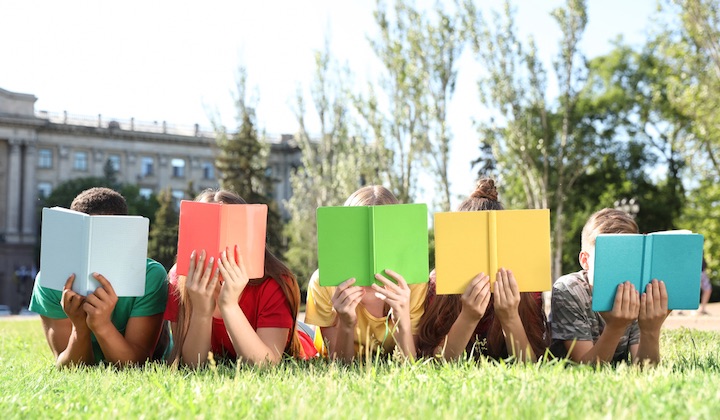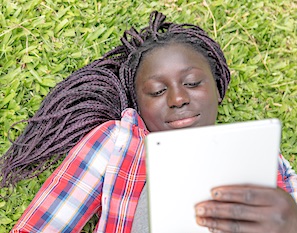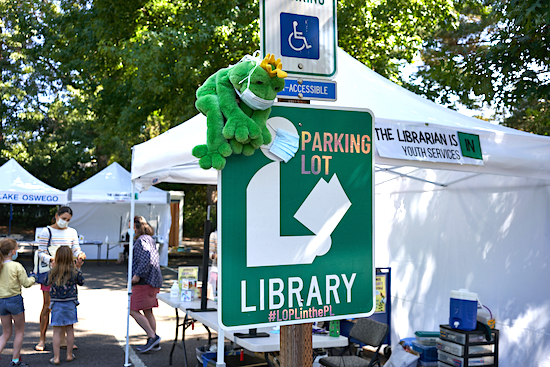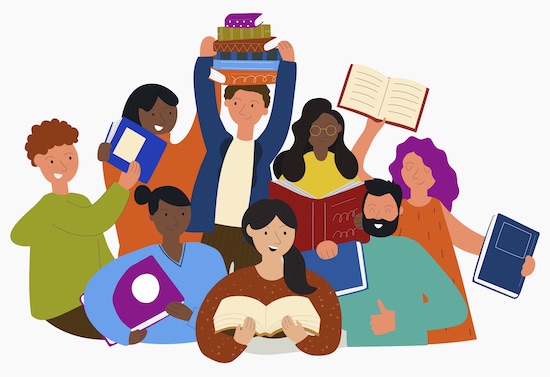Help Students Become Super Summer Readers
By Brenda Krupp, Lynne Dorfman and Aileen Hower

Brenda
Every teacher understands that reading proficiency is critical to every student’s success in school and as a global citizen in a complex and challenging world.
To continue to improve our fluency and comprehension and grow our vocabulary, we need to read year-round!
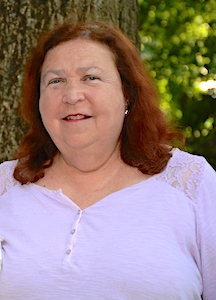
Lynne
The biggest break of the year is just around the corner, and it’s important to think about how we can keep all our students reading over these summer months. Summer reading is for everyone! Students who don’t read are at a real risk of falling behind their classmates.
What the Research Says
The summer effect on student achievement is well researched. It is important for school districts to design inclusive summer reading programs for all students (Gordon & Lu, 2008).
Research findings have consistently reported that student learning declines or remains the same during summer months, and the magnitude of the difference is based on socioeconomic status (Malach & Rutter, 2003).
Disadvantaged children showed the greatest losses, with a loss of three months of grade-level equivalency during the summer months each year, compared with an average of one month of loss by middle-income children when reading and math performances are combined (Alexander & Entwisle, 1996). Bottom line: when school is not in session during the summer, there are inequalities in educational opportunities.
While summer reading programs are a good idea, they often ignore the value of free choice, the importance of access, and the social aspects of reading. Summer reading lists often insist that reading be curricular and consist of “good” books. There is no attention paid to reading across nonprint media formats.
Research also shows that stimulating tasks increase situational interest and can increase reading motivation and comprehension (Guthrie, et al, 2006), yet summer reading tasks are often limited to a book report. For most reluctant or struggling readers, writing a report about what they have read is punitive, not rewarding.
Getting Ready for Summer Reading
If we want our students to read over the summer months, then we have to be more flexible in the choices we provide our students. Do we want everyone to enjoy being a reader, or are we more concerned that they read what we tell them to read?
Studies of summer reading in Massachusetts (Gordon & Lu, 2008) show that low-achieving students don’t think they have free choice, while high-achieving students think that they do. Perhaps this is true because low-achieving readers typically do not do much reading outside of school – in the summer or any other time – so most of their reading is mandated by the curriculum.
To make sure students have free choice, we have to provide alternatives to novels and the classics, including high-interest nonfiction books, magazines, graphic novels, newspapers, and even websites (Gordon & Lu, 2008). If schools encourage students to read what they actually enjoy reading, they will motivate them to read more.
Some Strategies to Build Reading Interest
Book talks – Short book talks offer a huge opportunity to introduce and “bless” books. They can be shared by both teachers and students; they can be digitized so that they can be reviewed after school or on weekends, and with families. They are a way to create excitement around books that someone has read, so that others can be more motivated to read them. Blessing the book means that someone you respect/listen to has shared positive feelings about a book.
Make time in the last weeks of the year to hold books talks. To prepare the way, have students record themselves to a YouTube channel or using FlipGrid and talk about books throughout the year. Tik Tok would be a great vehicle for this as well.
Write book reviews for class newsletter – Ask students to write a book review for one or several favorite reads to publish in a final newsletter that can be sent home electronically, shared on the classroom website, and perhaps included as a hard copy with the final report card. Don’t forget to model how to write a short, interesting book review. To help families find books once students are home, you might include links to book lists at sites like Amazon, Goodreads, ALA, Kirkus, LibraryThing, Book Riot, Bookish, Booklist, Fantasy Book Review, and the School Library Journal.
Top 10 lists in principal newsletters – Send suggestions for summer reading in lists from each grade level to the principal to be shared in his final newsletter. Perhaps they can be “Top Ten” lists from the grade level, so students need to be surveyed so their responses can be tallied, with the top ten books making the list.
These lists can be reading suggestions for the new students for the grade, so graduating fourth graders may want to look at the fifth-grade team’s list. Students should include the title of the book, the author’s name, # of pages, and publisher when it is possible. For 6th through 8th graders, teach your students about “red flags” – controversial issues such as death, violence, divorce, inappropriate language, etc. – and ask them to add red flags to the booklist if needed.
Book Swaps – Some students won’t have access to books in their home. They might not have regular access to a library over the summer either. A good way to get books into students’ hands for summer reading is to host a book swap in your classroom or school.
This is an opportunity for students who have books that they have read to pass them onto their classmates. Students who bring books can pick up a few as well among titles they have not read. Swaps keep the teacher from having to worry about where the funding for summer books might come from.
Visit from librarian to classrooms or assembly program – It’s a great idea to invite the local public librarian to your school to share the summer reading programs the local library has to offer. The librarian could speak to grade levels or in a larger assembly program. You could also ask the librarian if the library would be interested in older students (4th through 9th grade) participating in a read aloud program for younger students at a designated day and time.
Evening public library gathering to introduce summer reading programs (Title I) – While they might not admit it, middle school students (still) love teachers. Hosting a gathering to introduce summer reading programs or conduct book talks at the local library or local park is a great way to see former students and meet students you will work with in the upcoming school year.
One school hosts two events, one at the start and one at the end of the summer, where teachers choose one or two books to discuss with students. The school used its Title 1 funds to pay for books (students sign up in May and receive a book for each group they choose) and for some light snacks to be served. Students enjoy this time to see their friends as well as to hang out with the teacher to talk about books and how their summer is going.
Posting “Why I Read” signs in hallways and on websites – Posting “Why I Read” and “What I’m Currently Reading” signs outside of all school offices and classrooms promotes a culture of reading. Students can host a page in their online reader’s notebook to update what they are reading, or use Biblionasium (Goodreads for kids) to share what they’ve read and how they rate those reads. It’s a great place to find new book ideas too!
Introducing or reintroducing series books and popular children’s magazines – When given a choice of what to read, adolescents and tweens are more likely to choose – and to read – books that are part of a series. Interest in what might happen next often motivates students (and all of us!) to read the next book – we’re invested in the characters and want to know what’s going to happen to them next and how they’ll react. For middle schoolers, consider introducing The Artemis Fowl Series, The Song of the Lioness Series, The Knights and Bikes Series, Percy Jackson and the Olympians, The Devlin Quick Series, March series (graphic novels), and Jason Reynolds’s Track Series.
Easy Access to Books Is Important
Easy access to books is important to summer reading. An informal student survey can help teachers know what books are in the home and what are the family members’ reading habits. Information about access to books in the home can also be gathered during parent-teacher conferences.
One way to promote summer reading is to spend some time collecting books at garage and yard sales and saving them for students to choose several books or more as an end-of-the-school-year gift.
Schools or grade levels can also hold book swaps during the summer months, either in the school library, gym, or cafeteria, if this exchange is established with principal/district approval and a committee of teachers and parents become the volunteers to run the book swap. Flyers can be sent home and posted in local markets or on the school’s website or Facebook page.
Here are some other ideas:
► Open the school library several days during the summer (once a week – some mornings, some afternoons) so students can return what they’ve read and pick up new books.
► Have a BOGO book fair at the end of the school year where participants can buy one and get one free. Scholastic often gives schools the opportunity to do a BOGO fair as the year winds down to get more books into students’ hands.
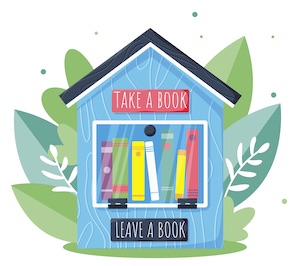
► Raise money from local businesses to get free books for summer reading. You may also be able to tap into a community/civic organization to get funds for books.
► Support bookmobiles run by teachers for designated neighborhoods. Teachers and students can create crates of books by collecting gently used volumes from their classroom libraries and from students. Before school finishes for the summer, set up dates, times, and locations. Brenda’s elementary school made 4 stops throughout their sending area. What fun the children had swapping books, getting new titles to read, chatting with their teachers, and getting book ideas from friends.
► Weed out your classroom library and gift books to your students. Students may have had their eye on one of those books all year, or perhaps hadn’t really considered it. Your book “gift” could be just what they need to get them reading.
► Visit garage sales, yard sales, auctions, etc. to buy large quantities of books for student choice at end-of-year. Distribute them in any of the many ways we’ve suggested. It’s great to offer these books as keepers for your students so they do not have to worry about returning them.
Ways to Sustain Summer Reading
One Book, One School – Choosing a book for the entire middle school to read is a memorable time for the entire school. We would recommend bringing together a committee that represents a diverse list of stakeholders (parents, specialists, administration, and teachers from all grades – student input is good too!). Sneak Peek morning announcements, and quiz questions announced in the morning for homeroom or first period class prizes, can add to the excitement and community building within the school.
For students who don’t read, having a favorite teacher reading chapters, with permission and not for public posting, can motivate students to keep going with the school-wide book. All teachers can talk about the text and connections it makes to their content area. It can also be used as an opportunity to talk about important subjects such as kindness or other social/emotional learning topics, culture, and acceptance.
Summer Book Clubs – Encourage families to start book clubs with relatives and friends who possibly live in another town or state. A Zoom book club meeting or Google conversations work best!
Library Visits/Programs – The local library often is a place where students have a wide range of books to choose from, and choice is important. Model your own library use during the school year so your students understand that you are a library user, too.
Virtual Author Visits – In general, virtual visits are much more cost-reasonable than in-person visits, and they don’t need to take up as much time. For summer visits, check with your local library about the possibilities and visit the websites of favorite authors to see what they have to offer. Author Kate Messner has become something of a role model for these virtual experiences.
Book Swaps (Outdoor or Indoor) – Same idea but keep it going all summer. Organize teams of parents, teachers, and teenagers to help with book swaps on one day for each month of summer vacation. Folding tables can be set up in front of the school, a local park, or wherever there is room. Books from garage and yard sales can get things started. Organize by genre, author, series, or simply fiction/nonfiction. Flyers can be sent home at the end of the year, and postings on the school district website or school signs can keep everyone informed of the date(s), time, and location.
 Some Cautions about Summer Reading
Some Cautions about Summer Reading
Summer reading and other reading motivation initiatives often have problems when they offer extrinsic rewards for reading. These rewards, combined with competition, suggest that students must be bribed or coaxed to read. If we broaden our view of what students can read, that is largely untrue.
Our students are reading. They are reading text messages, e-mails, and blogs. They are on the latest social media platforms. They thrive on social interaction. We need to meet our readers where they are, opening the door to reading for our tweens and teens by giving them choice and access to books and computers. Outdated methods that lead students “by the nose” to read – book reports, reading logs, prize-based contests for pages read – will not develop a love of reading in most kids today.
We should provide social interaction through reading clubs, literature circles, blogs, podcasts, and radio shows. Some social aspects of reading could be continued through summer months. Students can review books and report them in podcasts and other digital apps.
Let’s help our students be successful readers of new forms of literacy and create reading communities that translate reading into a social activity in an interactive digital environment. Let’s meet our students where they are!
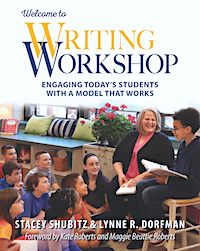
Brenda Krupp is an NWP fellow and co-facilitated the Pennsylvania Writing & Literature Project’s invitational writing institute for 16 years. She served Souderton Area School District as a third grade teacher and as a teacher leader.
Aileen Hower is past president of Keystone State Literacy Association and assistant professor and graduate coordinator of the Masters in Education in Language and Literacy at Millersville University, as well as the graduate coordinator of the Program Specialist in ESL Certification. Currently, she serves KSLA as the ILA coordinator.


